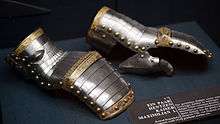Almain rivet

An Almain rivet is a type of flexible plate armour created in Germany in about 1500. It was designed to be manufactured easily whilst still affording considerable protection to the wearer. It consisted of a breastplate and backplate with laminated thigh-guards called tassets.[1] Almain rivets were generally of fairly low quality, but they were cheap: a royal proclamation issued by Henry VIII in 1542 designated them at 7s 6d, which equated to one sixth of the cost of a suit of demi-lance armor.[2] Almain rivets were frequently purchased en masse as munitions-grade armour to equip royal armies or personal retinues.
Nomenclature
The term rivet derives from the "overlapping plates sliding on rivets" characteristic of this type of armour.[3] Almain is the Early Modern English term for "German", from the French alemanique, from the mediaeval Latin alemanicus, from Alemanni, an early Germanic tribe.[4] The term was introduced in about 1530 and remained in use until about 1600. Based on the term almain-rivet, the word rivet itself acquired a meaning of "armour", attested (rarely) during the mid-16th century.[5]
See also
References
- ↑ Paul Cornish, Henry VIII's Army (Oxford: Osprey Publishing, 1987), 34.
- ↑ Cornish, Henry VIII's Army, 34.
- ↑ OED
- ↑ Larousse Dictionnaire de la Langue Francaise, Paris, 1979
- ↑ OED. Ffoulkes (1912:52) suggests that the term was from French revêtir, to clothe in, embellish with, from Latin vestire (Larousse, op.cit.)
- Cornish, Paul. Henry VIII's Army. Oxford: Osprey Publishing, 1987. ISBN 0-85045-798-X
- Ffoulkes, Charles. The Armourer and his Craft. New York: Dover Publications, 1912. ISBN 0-486-25851-3